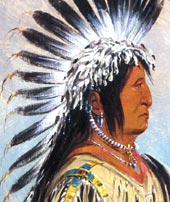
Every morning Francis would wrangle the horse so my cousin and I could ride and help him move cows from one pasture to another. The exception to his wrangling, however, was on Mondays after payday. Almost without fail, he would go on a drinking binge common on the “rez.” But this never tarnished my heroic image of Francis.
What I did not know at the time was just how different our lives really were. I came from a middle-class family where home ownership was a given, where going to college was expected, and where health care was excellent. Francis Calf-Looking, on the other hand, had a good job compared to other Indians on the reservation, but he would have lived in poverty had he not received room and board at the ranch. He probably didn’t complete high school, and his toothless grin was an indicator of substandard health care.
I don’t know whatever happened to Francis, but as I pursued my economics career I did reflect on just how diferent our lives were. It is obvious to the casual observer that the “First Nations” remain Third World nations surrounded by a sea of wealth.
Like the explanations of Third World poverty, the explanation of poverty on Indian reservations lies in the structure of property rights and the rule of law. And that is where PERC’s interest lies—how do the institutions in the form of laws, customs and rules on the reservations affect the stewardship of natural, human, and physical capital assets? The following insights into reservation institutions help us understand the problems surrounding stewardship and economic development.
LAND TENURE ON RESERVATIONS
My research on reservation economies began more than a decade ago when Dean Lueck and I examined the impact of land tenure on agricultural productivity (Anderson and Lueck 1992). Reservations, especially large western ones, are a mosaic of land ownership. Some land is privately owned (fee simple), some is allotted to tribal members and held in trust by the federal government (individual trust), and some is owned by the tribe and held in trust by the federal government (tribal trust.)
Because the latter two tenures are encumbered with extensive bureaucratic restrictions and because small parcels of individual trust lands can have hundreds of owners (this is known as the fractionation problem), Dean Lueck and I hypothesized that agricultural land owned in fee simple would be more productive. Indeed, we found that individual trust lands were 30 to 40 percent less productive and tribal trust lands were 80 to 90 percent less productive than fee simple lands. As with so many other PERC studies, these data show that institutions influence productivity and resource stewardship.
INSTITUTIONAL MYTHS
Just as property ownership is a key to stewardship, the tragedy of the commons results when property rights are lacking. A recent article by Jack Broughton published in the Ornithological Monographs examines the “Prehistoric Human Impacts on California Birds.” Broughton notes that explorers in California during the eighteenth and nineteenth centuries were amazed at “the abundance of artiodactyls, marine mammals, waterfowl, seabirds, and other animals . . . and the incredible wildlife densities reported in their accounts are routinely taken as analogues for the original or pristine zoological condition” (2004, 1). By carefully studying the Emeryville Shellmound, essentially a prehistoric garbage dump located near Emeryville, California, Broughton documents the decline and rise of bird populations between 2600 and 700 years ago. With these data, he tests the hypothesis that bird populations declined and disappeared because of hunting by humans. He concludes that the evidence of depression based on “declining relative abundances provides fairly secure evidence of exploitation depression or direct harvesting based mortality.” (44)
Put another way, Broughton’s data show that Native Americans and the wildlife on which they depended were not immune to the tragedy of the commons (Hardin 1968). They too overused and depleted resources that were open to all. He found this phenomenon with birds; we also know that before Europeans brought Great Plains bison to near-extinction, “the bufflo population was already being systematically overhunted” (Benson 2006, 56) by Indians fighting over tribal territories.
Anthropological records also show, however, that North American Indians had a rich institutional history centering on property rights (see Anderson 1996). For example, equestrian hunters who rode into stampeding buffalo herds marked their arrows so that they could tell who launched the lethal shot and therefore who would be rewarded with the choicest cuts of meat. As Bruce Johnsen (see page 15 in this issue) documents, American Indians even owned some salmon spawning streams; as a result, the salmon were better husbanded.
FINDING THE OTHER PATH
American Indians face choices in their future, as they have in the past. The powerful painting on page 3, “Pigeon’s Egg Head (The Light) Going to and Returning from Washington,”1 by George Catlin, suggests that two alternative paths for Native Americans have dominated their lives since the creation of reservations. The painting tells the story of “The Light,” who went to Washington, D.C., in the fall of 1831. As described in Catlin’s letters, “The Light” left for Washington dressed in traditional clothing but returned the next spring “with a complete suit en militaire, a colonel’s uniform of blue, presented to him by the President of the United States, with a beaver hat and feather, with epaulettes of gold—with sash and belt, and broad sword; with high-heeled boots—with a keg of whiskey under his arm, and a blue umbrella in his hand” (Catlin [1844], Letter 8.) The two paths are a museum-like traditional life and a life determined by the “Great White Father” (i.e., the federal government). The first may be romantic but is unlikely to help lift Indians from poverty. The second has made Indians “wards of the state,” dependent on governmental transfers with all of the accompanying social ills.
Some might contend that another path to wealth comes from Indian nations’ sovereign status. For example, this status allows tribes to capitalize on gaming opportunities. But, as Ronald Johnson points out (2006), gaming profits for Indians are likely to be short-lived. State governments are not likely to let tribes maintain their monopoly on gambling. Moreover, sovereignty is a two-edged sword. As Bill Yellowtail suggests in his essay in this issue (page 10), one edge gives tribes the potential to establish institutions necessary for economic development. Unfortunately, the other edge of the sovereign power is that it can be used to take wealth and discourage investment and trade, and this is what has happened in Indian country.
There is another path. Writing about the Third World, Hernando de Soto, in Mystery of Capital (2000), studied local communities from Peru to Africa, showing that top-down institutions typically thwart investment markets and the creation of productive capital. Indeed, de Soto earlier coined the term “the other path,” which consists of local control and local institutions that evolve from the bottom up, establishing a stable rule of law conducive to economic growth. This suggests the third path to economic growth for American Indians.
RULE OF LAW
Work that Dominic Parker and I did on the impact of state courts on Indian reservations hints at what this path might look like (Anderson and Parker 2006). In 1953 the federal government passed Public Law 280, which required some reservations to turn their judicial systems over to the states in which they reside. It mandated state jurisdiction over civil disputes and criminal offenses arising on reservations in some states and made this jurisdictional shift optional in others.
Because state courts have a reputation for providing a stable rule of law, the contrast between economic development on reservations under state jurisdiction and those with their own tribal courts provides a natural experiment for determining whether and how a stable rule of law might affect reservation economies. For a sample of 237 reservation economies between 1989 and 1999, we found that per-capita incomes are approximately 25 percent on reservations with state court jurisdiction. Percapita incomes on reservations with state court adjudication grew at rates approximately 15 percentage points higher than reservations with tribal court adjudication.
In the broadest sense, these empirical results underscore the critical role of secure property rights in determining whether reservation economies will grow or stagnate. The Anderson and Parker data suggest that the same variables important to economic prosperity in developing countries are important on Indian reservations. Without formal and informal institutions that lower transaction costs and reward productivity, reservation economies are likely to remain enclaves of poverty in a sea of prosperity.
REFERENCES
Anderson, Terry L. 1996. Conservation Native American Style. PERC Policy Series PS-6, July. Online: live-perc-wp.pantheonsite.io/perc.php?id=651 (cited May 2, 2006).
Anderson, Terry, and Dean Lueck. 1992. Land Tenure and Agricultural Productivity on Indian Reservations. Journal of Law and Economics 35(2): 427–54.
Anderson, Terry L., and Dominic P. Parker. 2006. The Wealth of Indian Nations Economics Performance and Institutions on Reservations. In Self-Determination: The Other Path for Native Americans, eds. Terry L. Anderson, Bruce L. Benson, Thomas E. Flanagan. Stanford, CA: Stanford University Press, Ch. 6.
Benson, Bruce. 2006. Property Rights and the Buffalo Economy of the Great Plains. In Self-Determination: The Other Path for Native Americans, eds. Terry L. Anderson, Bruce L. Benson, Thomas E. Flanagan. Stanford, CA: Stanford University Press, Ch. 2.
Broughton, Jack. 2004. Prehistoric Human Impacts on California Birds. Ornithological Monographs 56: 1–90.
Catlin, George.[1844]. Mouth of Yellow Stone, Upper Missouri (Letter No. 8). Letters and Notes on the Manners, Customs, and Conditions of North American Indians.
Online: www.catlinclassroom.si.edu/searchdocs/catlinletter8.html, (cited May 4, 2006).
De Soto, Hernando. 2000. The Mystery of Capital: Why Capitalism Triumphs in the West and Fails Everywhere Else. New York: Basic Books.
Hardin, Garrett, 1968. The Tragedy of the Commons. Science 162 (December 1243–48.
Johnson, Ronald N. 2006. Indian Casinos: Another Tragedy of the Commons. In Self-Determination: The Other Path for Native Americans, eds. Terry L. Anderson, Bruce L. Benson, Thomas E. Flanagan. Stanford, A: Stanford University Press, Ch. 8.
NOTE
1. This is the cover art for Self Determination: The Other Path for Native Americans, edited by Terry L. Anderson, Bruce L. Benson, and Thomas E. Flanagan, forthcoming from Stanford University Press. The oil painting is located at the Smithsonian American Art Museum.
TERRY L. ANDERSON is executive director of PERC, the Property and Environment Research Center, and a senior fellow at the Hoover Institution. He is coeditor with Bruce L. Benson and Thomas E. Flanagan of Self: Determination: The Other Path for Native Americans.



